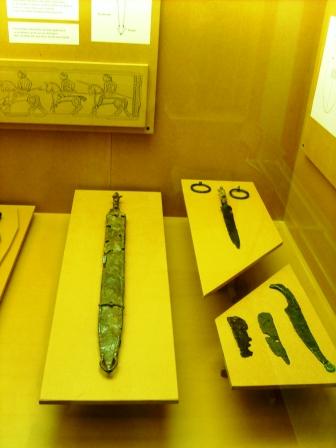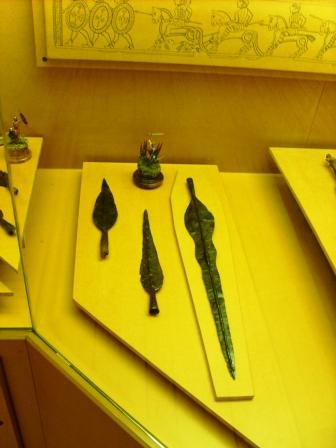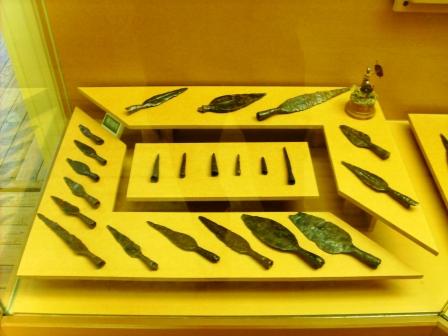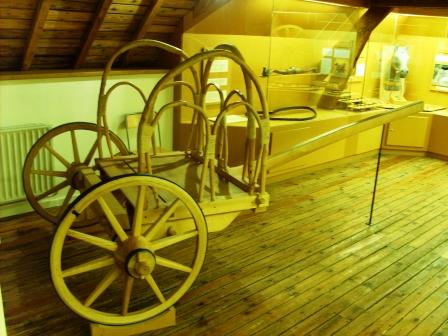| Author |
Message |
|
Jeroen Averhals
|
 Posted: Mon 15 Sep, 2008 3:06 am Post subject: narrow Celtic spear socket Posted: Mon 15 Sep, 2008 3:06 am Post subject: narrow Celtic spear socket |
 |
|
Yesterday I visited le Musée de Celtes in Libramont (Belgium) which has a a small collection of celtic swords, spears and lances. All artefacts have been found in the south of Belgium.
They also had a replica of a celtic chariot.
Here are the pictures.
I specially like the Gae Bolga, the flaming spearhead. Some say it couldn't be used in battle because the socket is to small to put in a decent (ash) pole. Is there a way to use this spearhead in battle or was it for parade?
thanks
Jeroen Averhals
 Attachment: 58.78 KB Attachment: 58.78 KB

Celtic sword in scabbard, rings to hold the scabbard, dagger and knives
 Attachment: 59.83 KB Attachment: 59.83 KB

two large spearheads and Gae Bolga
 Attachment: 64.44 KB Attachment: 64.44 KB

Celtic spearheads
 Attachment: 72.36 KB Attachment: 72.36 KB

Celtic chariot
Vigor et Veritas
Last edited by Jeroen Averhals on Mon 15 Sep, 2008 5:04 am; edited 1 time in total
|
|
  |
 |
|
Don Stanko
|
 Posted: Mon 15 Sep, 2008 3:25 am Post subject: Posted: Mon 15 Sep, 2008 3:25 am Post subject: |
 |
|
|
I know what you mean about socket size on older spearheads. It has always surprised me how narrow the sockets on migration and medieval spearheads are. I have several and most are the width of an index finger. I believe them to be battle weapons, judging by where the ones I own were found. It does seem that the shaft would be too weak to support a healthy thrust, maybe someone else has more information on this phenomenon.
|
|
  |
 |
|
Richard Hare
Location: Alberta, canada Joined: 15 Mar 2008
Posts: 135
|
 Posted: Mon 15 Sep, 2008 5:13 am Post subject: Posted: Mon 15 Sep, 2008 5:13 am Post subject: |
 |
|
Thank you for the pictures, Jeroen.
I would guess (that's all it is!) that Don is right, That these small sized shafts would be too thin for a good thrust, but see no problem with this.
It appears that often a few spears would be carried into battle, one for thrusting, and several for throwing. A thin light shaft, with a fairly heavy head makes sense.
Maybe something of the pilum mentality was at work By the time an oponent had extracated the thin-shafted spear from his shield, or body (!) or whatever, the shaft could well be damaged, and of no use to throw back!
Examples of amazingly thin spear-shafts can be seen in some "modern" African spears, without correspondingly "thin" heads.
Richard.
|
|
   |
 |
|
Jeroen Averhals
|
 Posted: Mon 15 Sep, 2008 5:20 am Post subject: Posted: Mon 15 Sep, 2008 5:20 am Post subject: |
 |
|
Thanks for your replies,
the pilum-theory could be possible but I wonder if one would use such al large spearhead (almost as large as the sword) as a throwing spear. I guess a lighter and smaller spearhead would go further.
Jeroen Averhals
Vigor et Veritas
|
|
  |
 |
Elling Polden

|
 Posted: Mon 15 Sep, 2008 5:47 am Post subject: Posted: Mon 15 Sep, 2008 5:47 am Post subject: |
 |
|
I have a one handed spear on a roughly 2cm ash pole. It is extremely whippy when used in two hands, but one handed it is not a problem. The head isn't very big thoug.
One thing to keep in mind is that spears, and especially spear shafts, are amunition. They where not made to last, as a shaft whacked with a sword would need to be replaced no matter how thick.
If you won lack of spearheads would not be a issue after the battle, if you lost you probably had other things to worry about.
"this [fight] looks curious, almost like a game. See, they are looking around them before they fall, to find a dry spot to fall on, or they are falling on their shields. Can you see blood on their cloths and weapons? No. This must be trickery."
-Reidar Sendeman, from King Sverre's Saga, 1201
|
|
    |
 |
|
C. Gadda
|
 Posted: Mon 15 Sep, 2008 10:20 am Post subject: Posted: Mon 15 Sep, 2008 10:20 am Post subject: |
 |
|
Keep in mind that it might also have been better quality wood, with closer growth rings, than is generally found today.
There does seem to be a noticeable difference in strength between modern timber and earlier wood, though I cannot quantify or explain it.
|
|
 |
 |
|
Matthew Amt
|
 Posted: Mon 15 Sep, 2008 12:15 pm Post subject: Posted: Mon 15 Sep, 2008 12:15 pm Post subject: |
 |
|
They also used coppiced ash for shafts, or at least saplings, so that the shaft had the entire grain of the wood. In other words, a cross-section would be concentric rings, not just the parallel lines seen in a shaft made from a piece of larger split or sawn lumber. So much stronger with less thickness and weight.
Though I do tend to agree that a few of those sockets can still look darn small!
Matthew
|
|
   |
 |
Douglas S

|
 Posted: Mon 20 Sep, 2010 2:09 pm Post subject: Posted: Mon 20 Sep, 2010 2:09 pm Post subject: |
 |
|
|
Possible that the diameter at the socket is not the final width of the shaft; it might have continued to widen.
|
|
  |
 |
Paul Hansen

|
 Posted: Mon 04 Oct, 2010 1:48 pm Post subject: Posted: Mon 04 Oct, 2010 1:48 pm Post subject: |
 |
|
Here you can find a statistical overview of 69 Anglo-Saxon spear head diameters:
http://forums.swordforum.com/showthread.php?t...amp;page=2
The smallest go down to 14mm... Different timeframe etc., but it shows that shafts may have been thinner (or more tapered) than often thought.
How big do you think this spearhead is?
|
|
  |
 |
|
Lafayette C Curtis
|
 Posted: Sun 10 Oct, 2010 8:02 am Post subject: Posted: Sun 10 Oct, 2010 8:02 am Post subject: |
 |
|
| Jeroen Averhals wrote: | | the pilum-theory could be possible but I wonder if one would use such al large spearhead (almost as large as the sword) as a throwing spear. I guess a lighter and smaller spearhead would go further. |
It depends. If the head was too light and too small, then the weapon as a whole might not have enough weight to stabilize itself in a long throw, so in fact I'd want quite a heavy head on a throwing spear with a flimsy shaft. Otherwise the spear simply wouldn't have enough inertia to carry itself against aerodynamic drag and thus would be slowed down much too quickly.
|
|
  |
 |
Jared Smith

|
 Posted: Sun 10 Oct, 2010 8:58 am Post subject: Posted: Sun 10 Oct, 2010 8:58 am Post subject: |
 |
|
I would expect at least some of these spear heads to have been hafted so that they could be thrown effectively. Several authors mentioned volley's of thrown weapons, including spears, from pre-Roman Gaul era through Merovingian era. Some Medieval illustrations of cavalry even seem to depict lances flying through the air as if the horsemen had thrown them as late as 11th or 12th century.
If we agree on the concept of sizing a shaft for throwing, than one can see that a men's, regulation, minimum allowable length, Olympic javelin made of solid "green air dried ash" (about 0.85 gram/ cm^3 density) has ample mass left for head weight if it has an average shaft diameter of 1 cm or slightly larger. A tapering design is actually preferred such that the shaft would be thicker near the center and butt than at the head. However, if the javelin shaft has an average diameter of 3/4" (about 1.9 cm), the mass taken up by the ash lumber leaves almost no room or remaining weight for head mass, and it's impractical.
The small shaft size sounds suspicious, but bowyers and others will appreciate the resilience of somewhat green staves made from straight young saplings with growth rings intact all of the way up and down the stave. I think it was Procopius who described Merovingians as thrusting winged spears into opponents shields, and then stepping on the hafts to drag down the opponent's shield. In that case, he mentioned the spear shaft as being "covered in iron." I have wondered if that was something like thin reinforcement strips of iron meant to prevent a thin shaft from breaking.........
Absence of evidence is not necessarily evidence of absence!
|
|
  |
 |
|
Lafayette C Curtis
|
 Posted: Sun 10 Oct, 2010 9:02 am Post subject: Posted: Sun 10 Oct, 2010 9:02 am Post subject: |
 |
|
| Jared Smith wrote: | | Some Medieval illustrations of cavalry even seem to depict lances flying through the air as if the horsemen had thrown them as late as 11th or 12th century. |
Indeed. I've seen 1150-1185 being quoted as the end date where the couched lance technique finally rose to dominance over the other techniques (thrust and thrown) used concurrently up until then. Of course, in Spain, lances were thrown around for a bit longer yet, perhaps even as late as the time of the Hundred Years' War (when extensive English and French intervention in a Spanish civil war brought the Iberians more up-to-date with developments elsewhere in tactics, techniques, and equipment).
|
|
  |
 |
Paul Hansen

|
 Posted: Tue 12 Oct, 2010 9:24 pm Post subject: Posted: Tue 12 Oct, 2010 9:24 pm Post subject: |
 |
|
| Jared Smith wrote: | | I think it was Procopius who described Merovingians as thrusting winged spears into opponents shields, and then stepping on the hafts to drag down the opponent's shield. In that case, he mentioned the spear shaft as being "covered in iron." I have wondered if that was something like thin reinforcement strips of iron meant to prevent a thin shaft from breaking......... |
According to Wikipedia, it was Agathias, who was describing the use of the angon (the Frankish version of the pilum), so with a long iron shaft. I don't know if "angon" was the actual word used by Agathias, but the iron shaft makes sense. Before I found the Wiki article, I also immediately thought "probably an angon".
http://en.wikipedia.org/wiki/Angon
|
|
  |
 |
T Franks

|
 Posted: Wed 29 Dec, 2010 1:37 pm Post subject: Posted: Wed 29 Dec, 2010 1:37 pm Post subject: |
 |
|
|
Thank you for these valuable pics Jeroen. I'm always interested in seeing actual la tene examples. Do you know which la tene phase the museum attributes these to? The sword definately looks earlier la tene, but I am especially curious about that knife. That sucker looks like it could be a war knife. I'd love to get a closer look, as i'm not sure if I have ever seen this particular example in a picture before. From here it looks like I havn't. I am curious to know if these items are from a specific find, or are they just multiple la tene items from the general southern belgium region put together for display?
|
|
  |
 |
T Franks

|
 Posted: Wed 29 Dec, 2010 1:53 pm Post subject: Posted: Wed 29 Dec, 2010 1:53 pm Post subject: |
 |
|
Ah, found the website. You can find out some more specifics about some individual items (including spears) here.
http://www.aicim.be/main/fr/membres.php?provider=MCE
Nice info, but it don't beat seeing them in person like Jeroen did, im sure! 
|
|
  |
 |
|
|

